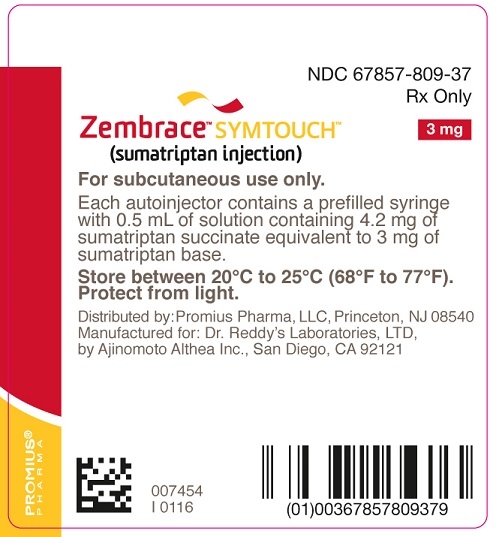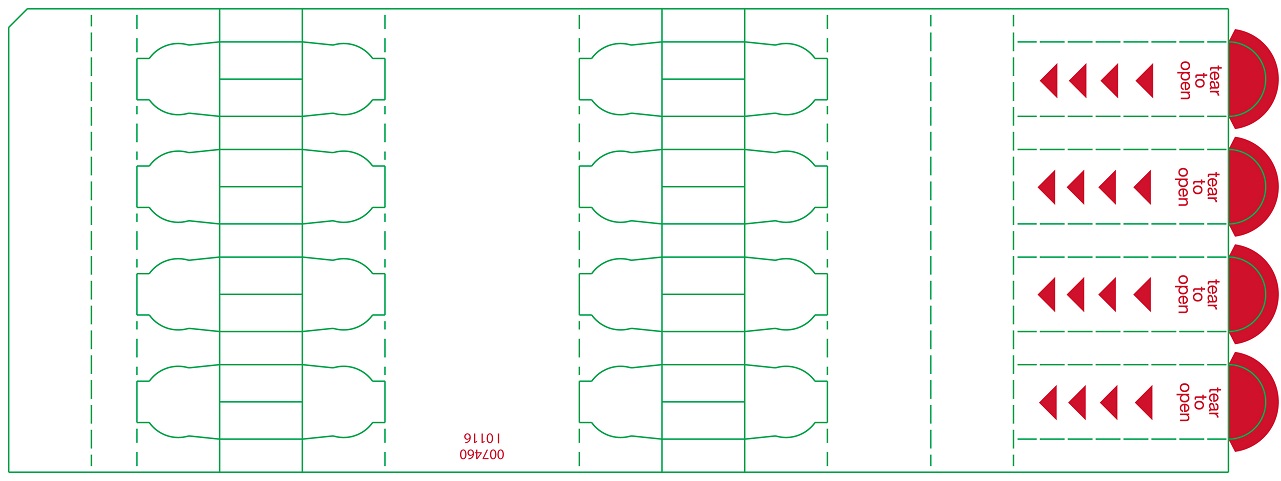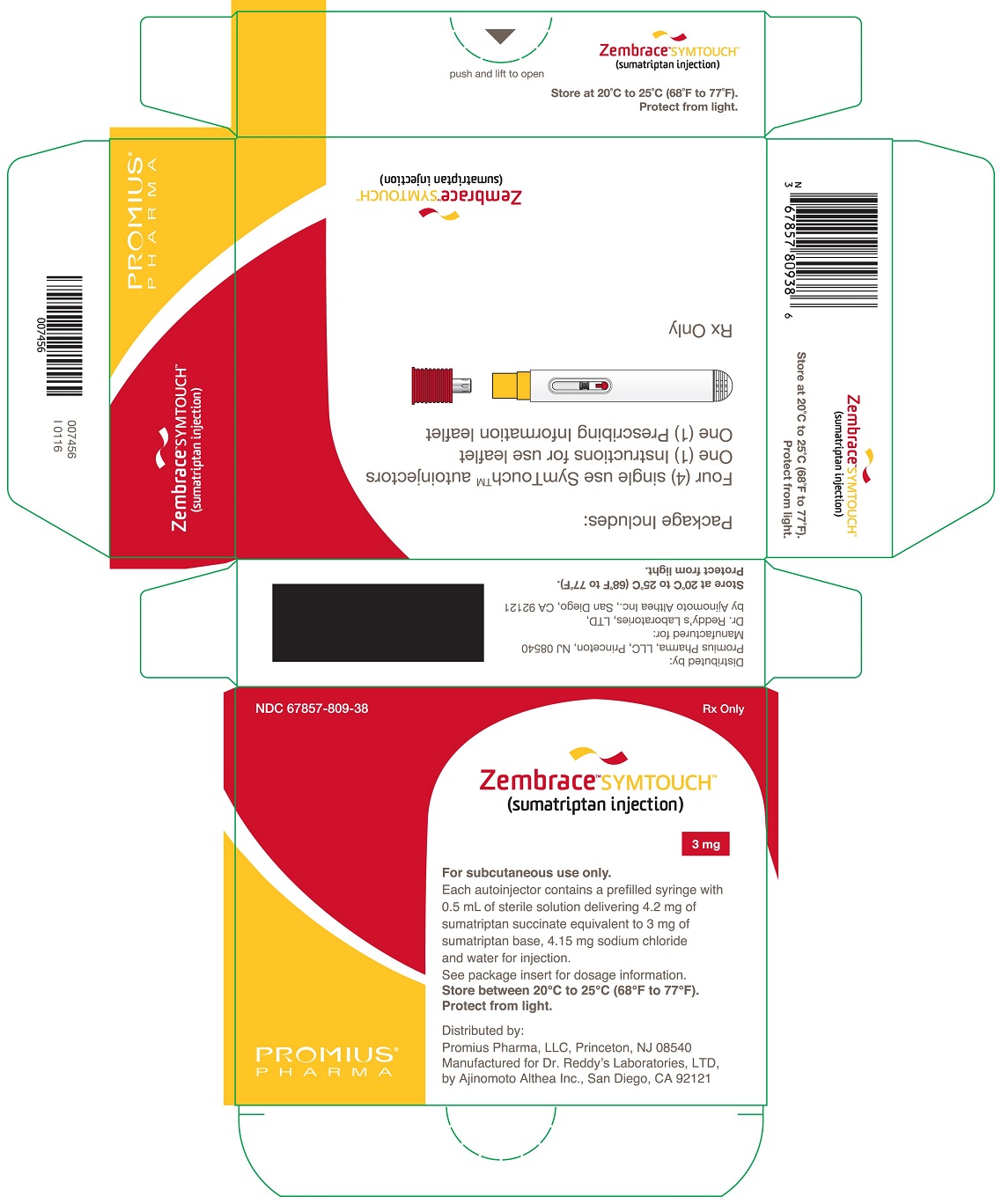ZEMBRACE SYMTOUCH- sumatriptan injection, solution
ZEMBRACE SymTouch by
Drug Labeling and Warnings
ZEMBRACE SymTouch by is a Prescription medication manufactured, distributed, or labeled by Promius Pharma, LLC. Drug facts, warnings, and ingredients follow.
Drug Details [pdf]
-
HIGHLIGHTS OF PRESCRIBING INFORMATION
These highlights do not include all the information needed to use ZEMBRACE™ SymTouch™ safely and effectively. See full prescribing information for ZEMBRACE™ SymTouch™.
ZEMBRACE™ SymTouch™ (sumatriptan succinate) Injection, for
subcutaneous use
Initial U.S. Approval: 1992RECENT MAJOR CHANGES
Warnings and Precautions (5.9) 06/2019
INDICATIONS AND USAGE
DOSAGE AND ADMINISTRATION
DOSAGE FORMS AND STRENGTHS
- Injection: 3-mg prefilled, ready-to use, single-dose disposable autoinjector. (3)
CONTRAINDICATIONS
- History of coronary artery disease or coronary vasospasm (4)
- Wolff-Parkinson-White syndrome or other cardiac accessory conduction pathway disorders (4)
- History of stroke, transient ischemic attack, or hemiplegic or basilar migraine (4)
- Peripheral vascular disease (4)
- Ischemic bowel disease (4)
- Uncontrolled hypertension (4)
- Recent (within 24 hours) use of another 5-HT1 agonist (e.g., another triptan) or of an ergotamine-containing medication (4)
- Concurrent or recent (past 2 weeks) use of monoamine oxidase-A inhibitor (4)
- Hypersensitivity to sumatriptan (angioedema and anaphylaxis seen) (4)
- Severe hepatic impairment (4)
WARNINGS AND PRECAUTIONS
- Myocardial ischemia/infarction and Prinzmetal’s angina: Perform cardiac evaluation in patients with multiple cardiovascular risk factors. (5.1)
- Arrhythmias: Discontinue ZEMBRACE SymTouch if occurs. (5.2)
- Chest/throat/neck/jaw pain, tightness, pressure, or heaviness: Generally not associated with myocardial ischemia; evaluate for coronary artery disease in patients at high risk. (5.3)
- Cerebral hemorrhage, subarachnoid hemorrhage, and stroke: Discontinue ZEMBRACE SymTouch if occurs. (5.4)
- Gastrointestinal ischemia and reactions, peripheral vasospastic reactions: Discontinue ZEMBRACE SymTouch if occurs. (5.5)
- Medication overuse headache: Detoxification may be necessary. (5.6)
- Serotonin syndrome: Discontinue ZEMBRACE SymTouch if occurs. (5.7)
- Seizures: Use with caution in patients with epilepsy or a lowered seizure threshold. (5.10)
ADVERSE REACTIONS
Most common adverse reactions (≥5% and > placebo) were injection site reactions, tingling, dizziness/vertigo, warm/hot sensation, burning sensation, feeling of heaviness, pressure sensation, flushing, feeling of tightness, and numbness/paresthesia. (6.1)
To report SUSPECTED ADVERSE REACTIONS, contact Promius Pharma, LLC. at 1-888-966-8766 or FDA at 1-800-FDA-1088 or www.fda.gov/medwatch.
USE IN SPECIFIC POPULATIONS
- Pregnancy: Based on animal data, may cause fetal harm. (8.1)
See 17 for PATIENT COUNSELING INFORMATION and FDA-approved patient labeling.
Revised: 6/2019
-
Table of Contents
FULL PRESCRIBING INFORMATION: CONTENTS*
1 INDICATIONS AND USAGE
2 DOSAGE AND ADMINISTRATION
2.1 Dosing Information
2.2 Administration Using ZEMBRACE SymTouch
3 DOSAGE FORMS AND STRENGTHS
4 CONTRAINDICATIONS
5 WARNINGS AND PRECAUTIONS
5.1 Myocardial Ischemia, Myocardial Infarction, and Prinzmetal’s Angina
5.2 Arrhythmias
5.3 Chest, Throat, Neck, and/or Jaw Pain/Tightness/Pressure
5.4 Cerebrovascular Events
5.5 Other Vasospasm Reactions
5.6 Medication Overuse Headache
5.7 Serotonin Syndrome
5.8 Increase in Blood Pressure
5.9 Hypersensitivity Reactions
5.10 Seizures
6 ADVERSE REACTIONS
6.1 Clinical Trials Experience
6.2 Postmarketing Experience
7 DRUG INTERACTIONS
7.1 Ergot-Containing Drugs
7.2 Monoamine Oxidase-A Inhibitors
7.3 Other 5-HT1 Agonists
7.4 Selective Serotonin Reuptake Inhibitors/Serotonin Norepinephrine Reuptake Inhibitors and Serotonin Syndrome
8 USE IN SPECIFIC POPULATIONS
8.1 Pregnancy
8.2 Lactation
8.4 Pediatric Use
8.5 Geriatric Use
10 OVERDOSAGE
11 DESCRIPTION
12 CLINICAL PHARMACOLOGY
12.1 Mechanism of Action
12.2 Pharmacodynamics
12.3 Pharmacokinetics
13 NONCLINICAL TOXICOLOGY
13.1 Carcinogenesis, Mutagenesis, Impairment of Fertility
13.2 Animal Toxicology and/or Pharmacology
14 CLINICAL STUDIES
16 HOW SUPPLIED/STORAGE AND HANDLING
16.1 How Supplied
16.2 Storage and Handling
17 PATIENT COUNSELING INFORMATION
- * Sections or subsections omitted from the full prescribing information are not listed.
-
1 INDICATIONS AND USAGE
ZEMBRACE SymTouch is indicated for the acute treatment of migraine with or without aura in adults.
Limitations of Use:
- Use only if a clear diagnosis of migraine has been established. If a patient has no response to the first migraine attack treated with ZEMBRACE SymTouch, reconsider the diagnosis before ZEMBRACE SymTouch is administered to treat any subsequent attacks.
- ZEMBRACE SymTouch injection is not indicated for the prevention of migraine attacks.
-
2 DOSAGE AND ADMINISTRATION
2.1 Dosing Information
The recommended dose of ZEMBRACE SymTouch is 3 mg injected subcutaneously.
The maximum cumulative injected dose that may be given in 24 hours is 12 mg, with doses of ZEMBRACE SymTouch separated by at least 1 hour. ZEMBRACE SymTouch may also be given at least 1 hour following a dose of another sumatriptan product.
2.2 Administration Using ZEMBRACE SymTouch
ZEMBRACE SymTouch is available as a prefilled, ready-to-use, single dose, disposable auto-injector containing 3 mg sumatriptan. With ZEMBRACE SymTouch, the needle penetrates approximately ¼ inch (6 mm). The injection is intended to be given subcutaneously. Do not administer by any other route. Instruct patients on the proper use of ZEMBRACE SymTouch and direct them to use injection sites with an adequate skin and subcutaneous thickness to accommodate the length of the needle.
- 3 DOSAGE FORMS AND STRENGTHS
-
4 CONTRAINDICATIONS
ZEMBRACE SymTouch injection is contraindicated in patients with:
- Ischemic coronary artery disease (CAD) (angina pectoris, history of myocardial infarction, or documented silent ischemia) or coronary artery vasospasm, including Prinzmetal’s angina [see Warnings and Precautions (5.1)].
- Wolff-Parkinson-White syndrome or arrhythmias associated with other cardiac accessory conduction pathway disorders [see Warnings and Precautions (5.2)].
- History of stroke or transient ischemic attack (TIA) or history of hemiplegic or basilar migraine because these patients are at a higher risk of stroke [see Warnings and Precautions (5.4)].
- Peripheral vascular disease [see Warnings and Precautions (5.5)].
- Ischemic bowel disease [see Warnings and Precautions (5.5)].
- Uncontrolled hypertension [see Warnings and Precautions (5.8)].
- Recent (i.e., within 24 hours) use of ergotamine-containing medication, ergot-type medication (such as dihydroergotamine or methysergide), or another 5-hydroxytryptamine1 (5-HT1) agonist [see Drug Interactions (7.1, 7.3)].
- Concurrent administration of an MAO-A inhibitor or recent (within 2 weeks) use of an MAO-A inhibitor [see Drug Interactions (7.2) and Clinical Pharmacology (12.3)].
- Known hypersensitivity to sumatriptan (angioedema and anaphylaxis seen) [see Warnings and Precautions (5.9)].
- Severe hepatic impairment [see Clinical Pharmacology (12.3)].
-
5 WARNINGS AND PRECAUTIONS
5.1 Myocardial Ischemia, Myocardial Infarction, and Prinzmetal’s Angina
The use of ZEMBRACE SymTouch injection is contraindicated in patients with ischemic or vasospastic CAD. There have been rare reports of serious cardiac adverse reactions, including acute myocardial infarction, occurring within a few hours following administration of sumatriptan injection. Some of these reactions occurred in patients without known CAD. 5-HT1 agonists, including ZEMBRACE SymTouch injection, may cause coronary artery vasospasm (Prinzmetal’s angina), even in patients without a history of CAD.
Perform a cardiovascular evaluation in triptan-naive patients who have multiple cardiovascular risk factors (e.g., increased age, diabetes, hypertension, smoking, obesity, strong family history of CAD) prior to receiving ZEMBRACE SymTouch injection. If there is evidence of CAD or coronary artery vasospasm, ZEMBRACE SymTouch injection is contraindicated. For patients with multiple cardiovascular risk factors who have a negative cardiovascular evaluation, consider administering the first dose of ZEMBRACE SymTouch injection in a medically supervised setting and performing an electrocardiogram (ECG) immediately following ZEMBRACE SymTouch injection. For such patients, consider periodic cardiovascular evaluation in intermittent long-term users of ZEMBRACE SymTouch injection.
5.2 Arrhythmias
Life-threatening disturbances of cardiac rhythm, including ventricular tachycardia and ventricular fibrillation leading to death, have been reported within a few hours following the administration of 5-HT1 agonists. Discontinue ZEMBRACE SymTouch injection if these disturbances occur. ZEMBRACE SymTouch injection is contraindicated in patients with Wolff-Parkinson-White syndrome or arrhythmias associated with other cardiac accessory conduction pathway disorders.
5.3 Chest, Throat, Neck, and/or Jaw Pain/Tightness/Pressure
Sensations of tightness, pain, pressure, and heaviness in the precordium, throat, neck, and jaw commonly occur after treatment with sumatriptan injection and are usually non-cardiac in origin. However, perform a cardiac evaluation if these patients are at high cardiac risk. The use of ZEMBRACE SymTouch injection is contraindicated in patients with CAD and those with Prinzmetal’s variant angina.
5.4 Cerebrovascular Events
Cerebral hemorrhage, subarachnoid hemorrhage, and stroke have occurred in patients treated with 5-HT1 agonists, and some have resulted in fatalities. In a number of cases, it appears possible that the cerebrovascular events were primary, the 5-HT1 agonist having been administered in the incorrect belief that the symptoms experienced were a consequence of migraine when they were not. Also, patients with migraine may be at increased risk of certain cerebrovascular events (e.g., stroke, hemorrhage, TIA). Discontinue ZEMBRACE SymTouch injection if a cerebrovascular event occurs.
Before treating headaches in patients not previously diagnosed with migraine or in patients who present with atypical symptoms, exclude other potentially serious neurological conditions. ZEMBRACE SymTouch injection is contraindicated in patients with a history of stroke or TIA.
5.5 Other Vasospasm Reactions
ZEMBRACE SymTouch injection may cause non-coronary vasospastic reactions, such as peripheral vascular ischemia, gastrointestinal vascular ischemia and infarction (presenting with abdominal pain and bloody diarrhea), splenic infarction, and Raynaud’s syndrome. In patients who experience symptoms or signs suggestive of non-coronary vasospasm reaction following the use of any 5-HT1 agonist, rule out a vasospastic reaction before receiving additional ZEMBRACE SymTouch injections.
Reports of transient and permanent blindness and significant partial vision loss have been reported with the use of 5-HT1 agonists. Since visual disorders may be part of a migraine attack, a causal relationship between these events and the use of 5-HT1 agonists have not been clearly established.
5.6 Medication Overuse Headache
Overuse of acute migraine drugs (e.g., ergotamine, triptans, opioids, combination of these drugs for 10 or more days per month) may lead to exacerbation of headache (medication overuse headache). Medication overuse headache may present as migraine-like daily headaches, or as a marked increase in frequency of migraine attacks. Detoxification of patients, including withdrawal of the overused drugs, and treatment of withdrawal symptoms (which often includes a transient worsening of headache) may be necessary.
5.7 Serotonin Syndrome
Serotonin syndrome may occur with ZEMBRACE SymTouch injection, particularly during co-administration with selective serotonin reuptake inhibitors (SSRIs), serotonin norepinephrine reuptake inhibitors (SNRIs), tricyclic antidepressants (TCAs), and MAO inhibitors [see Drug Interactions (7.4)]. Serotonin syndrome symptoms may include mental status changes (e.g., agitation, hallucinations, coma), autonomic instability (e.g., tachycardia, labile blood pressure, hyperthermia), neuromuscular aberrations (e.g., hyperreflexia, incoordination), and/or gastrointestinal symptoms (e.g., nausea, vomiting, diarrhea). The onset of symptoms usually occurs within minutes to hours of receiving a new or a greater dose of a serotonergic medication. Discontinue ZEMBRACE SymTouch injection if serotonin syndrome is suspected.
5.8 Increase in Blood Pressure
Significant elevation in blood pressure, including hypertensive crisis with acute impairment of organ systems, has been reported on rare occasions in patients treated with 5-HT1 agonists, including patients without a history of hypertension. Monitor blood pressure in patients treated with ZEMBRACE SymTouch. ZEMBRACE SymTouch injection is contraindicated in patients with uncontrolled hypertension.
5.9 Hypersensitivity Reactions
Hypersensitivity reactions, including angioedema and anaphylaxis, have occurred in patients receiving sumatriptan. Such reactions can be life threatening or fatal. In general, anaphylactic reactions to drugs are more likely to occur in individuals with a history of sensitivity to multiple allergens. ZEMBRACE SymTouch injection is contraindicated in patients with a history of hypersensitivity reaction to sumatriptan.
5.10 Seizures
Seizures have been reported following administration of sumatriptan. Some have occurred in patients with either a history of seizures or concurrent conditions predisposing to seizures. There are also reports in patients where no such predisposing factors are apparent. ZEMBRACE SymTouch injection should be used with caution in patients with a history of epilepsy or conditions associated with a lowered seizure threshold.
-
6 ADVERSE REACTIONS
The following serious adverse reactions are described below and elsewhere in the labeling:
- Myocardial ischemia, myocardial infarction, and Prinzmetal’s angina [see Warnings and Precautions (5.1)]
- Arrhythmias [see Warnings and Precautions (5.2)]
- Chest, throat, neck, and/or jaw pain/tightness/pressure [see Warnings and Precautions (5.3)]
- Cerebrovascular events [see Warnings and Precautions (5.4)]
- Other vasospasm reactions [see Warnings and Precautions (5.5)]
- Medication overuse headache [see Warnings and Precautions (5.6)]
- Serotonin syndrome [see Warnings and Precautions (5.7)]
- Increase in blood pressure [see Warnings and Precautions (5.8)]
- Hypersensitivity reactions [see Contraindications (4), Warnings and Precautions (5.9)]
- Seizures [see Warnings and Precautions (5.10)]
6.1 Clinical Trials Experience
Because clinical trials are conducted under widely varying conditions, adverse reaction rates observed in the clinical trials of a drug cannot be directly compared with rates in the clinical trials of another drug and may not reflect the rates observed in practice.
Adverse Reactions in Placebo-Controlled Trials with Sumatriptan Injection
Migraine Headache:Table 1 lists adverse reactions that occurred in 2 US placebo-controlled clinical trials in migraine subjects (Studies 2 and 3), following either a single 6-mg dose of sumatriptan injection or placebo. Only reactions that occurred at a frequency of 2% or more in groups treated with sumatriptan injection 6 mg and that occurred at a frequency greater than the placebo group are included in Table 1.
Table 1: Adverse Reactions in Pooled Placebo-Controlled Trials in Patients with Migraine (Studies 2 and 3) a Includes injection site pain, stinging/burning, swelling, erythema, bruising, bleeding. Adverse Reaction Percent of Subjects Reporting Sumatriptan
Injection 6 mg
Subcutaneous
(n = 547)Placebo
(n = 370)Atypical sensations
Tingling
Warm/hot sensation
Burning sensation
Feeling of heaviness
Pressure sensation
Feeling of tightness
Numbness
Feeling strange
Tight feeling in head42
14
11
7
7
7
5
5
2
29
3
4
<1
1
2
<1
2
<1
<1Cardiovascular
Flushing
Chest discomfort
Tightness in chest
Pressure in chest
7
5
3
2
2
1
<1
<1Ear, nose, and throat
Throat discomfort
Discomfort: nasal cavity/sinuses
3
2
<1
<1Injection site reactiona 59 24 Miscellaneous
Jaw discomfort
2
0Musculoskeletal
Weakness
Neck pain/stiffness
Myalgia
5
5
2
<1
<1
<1
Neurological
Dizziness/vertigo
Drowsiness/sedation
Headache
12
3
2
4
2
<1
Skin
Sweating2 1 The incidence of adverse reactions in controlled clinical trials was not affected by gender or age of the patients. There were insufficient data to assess the impact of race on the incidence of adverse reactions.
Adverse Reactions in a Study with ZEMBRACE SymTouch
The most common adverse reactions in a placebo-controlled trial with ZEMBRACE SymTouch were injection site reactions (including injection site bruising, erythema, hemorrhage, induration, irritation, pain, paresthesia, pruritis, swelling, and urticaria), occurring in 30% of ZEMBRACE SymTouch-treated patients compared to 13% of placebo-treated patients. Adverse reactions with ZEMRACE SymTouch are expected to be similar to those observed with sumatriptan injection.
6.2 Postmarketing Experience
The following adverse reactions have been identified during postapproval use of sumatriptan tablets, sumatriptan nasal spray, and sumatriptan injection. Because these reactions are reported voluntarily from a population of uncertain size, it is not always possible to reliably estimate their frequency or establish a causal relationship to drug exposure.
Cardiovascular
Hypotension, palpitations
Neurological
Dystonia, tremor
-
7 DRUG INTERACTIONS
7.1 Ergot-Containing Drugs
Ergot-containing drugs have been reported to cause prolonged vasospastic reactions. Because these effects may be additive, use of ergotamine-containing or ergot-type medications (like dihydroergotamine or methysergide) and ZEMBRACE SymTouch within 24 hours of each other is contraindicated.
7.2 Monoamine Oxidase-A Inhibitors
MAO-A inhibitors increase systemic exposure by 2-fold. Therefore, the use of ZEMBRACE SymTouch injection in patients receiving MAO-A inhibitors is contraindicated [see Clinical Pharmacology (12.3)].
7.3 Other 5-HT1 Agonists
Because their vasospastic effects may be additive, coadministration of ZEMBRACE SymTouch injection and other 5-HT1 agonists (e.g., triptans) within 24 hours of each other is contraindicated.
7.4 Selective Serotonin Reuptake Inhibitors/Serotonin Norepinephrine Reuptake Inhibitors and Serotonin Syndrome
Cases of serotonin syndrome have been reported during coadministration of triptans and SSRIs, SNRIs, TCAs, and MAO inhibitors [see Warnings and Precautions (5.7)].
-
8 USE IN SPECIFIC POPULATIONS
8.1 Pregnancy
Risk Summary
Data from a prospective pregnancy exposure registry and epidemiological studies of pregnant women have not detected an increased frequency of birth defects or a consistent pattern of birth defects among women exposed to sumatriptan compared with the general population (see Data). In developmental toxicity studies in rats and rabbits, oral administration of sumatriptan to pregnant animals was associated with embryolethality, fetal abnormalities, and pup mortality. When administered by the intravenous route to pregnant rabbits, sumatriptan was embryolethal (see Data).
In the U.S. general population, the estimated background risk of major birth defects and of miscarriage in clinically recognized pregnancies is 2% to 4% and 15% to 20%, respectively. The reported rate of major birth defects among deliveries to women with migraine ranged from 2.2% to 2.9% and the reported rate of miscarriage was 17%, which were similar to rates reported in women without migraine.
Clinical Considerations
Disease-Associated Maternal and/or Embryo/Fetal Risk: Several studies have suggested that women with migraine may be at increased risk of preeclampsia during pregnancy.
Data
Human Data
The Sumatriptan/Naratriptan/Treximet (sumatriptan and naproxen sodium) Pregnancy Registry, a population-based international prospective study, collected data for sumatriptan from January 1996 to September 2012. The Registry documented outcomes of 626 infants and fetuses exposed to sumatriptan during pregnancy (528 with earliest exposure during the first trimester, 78 during the second trimester, 16 during the third trimester, and 4 unknown). The occurrence of major birth defects (excluding fetal deaths and induced abortions without reported defects and all spontaneous pregnancy losses) during first-trimester exposure to sumatriptan was 4.2% (20/478 [95% CI: 2.6% to 6.5%]) and during any trimester of exposure was 4.2% (24/576 [95% CI: 2.7% to 6.2%]). The sample size in this study had 80% power to detect at least a 1.73-to 1.91-fold increase in the rate of major malformations. The number of exposed pregnancy outcomes accumulated during the registry was insufficient to support definitive conclusions about overall malformation risk or for making comparisons of the frequencies of specific birth defects. Of the 20 infants with reported birth defects after exposure to sumatriptan in the first trimester, 4 infants had ventricular septal defects, including one infant who was exposed to both sumatriptan and naratriptan, and 3 infants had pyloric stenosis. No other birth defect was reported for more than 2 infants in this group.
In a study using data from the Swedish Medical Birth Register, live births to women who reported using triptans or ergots during pregnancy were compared with those of women who did not. Of the 2,257 births with first-trimester exposure to sumatriptan, 107 infants were born with malformations (relative risk 0.99 [95% CI: 0.91 to 1.21]). A study using linked data from the Medical Birth Registry of Norway to the Norwegian Prescription Database compared pregnancy outcomes in women who redeemed prescriptions for triptans during pregnancy, as well as a migraine disease comparison group who redeemed prescriptions for sumatriptan before pregnancy only, compared with a population control group. Of the 415 women who redeemed prescriptions for sumatriptan during the first trimester, 15 had infants with major congenital malformations (OR 1.16 [95% CI: 0.69 to 1.94]) while for the 364 women who redeemed prescriptions for sumatriptan before, but not during, pregnancy, 20 had infants with major congenital malformations (OR 1.83 [95% CI: 1.17 to 2.88]), each compared with the population comparison group. Additional smaller observational studies evaluating use of sumatriptan during pregnancy have not suggested an increased risk of teratogenicity.
Animal Data
Oral administration of sumatriptan to pregnant rats during the period of organogenesis resulted in an increased incidence of fetal blood vessel (cervicothoracic and umbilical) abnormalities. The highest no-effect dose for embryofetal developmental toxicity in rats was 60 mg/kg/day. Oral administration of sumatriptan to pregnant rabbits during the period of organogenesis resulted in increased incidences of embryolethality and fetal cervicothoracic vascular and skeletal abnormalities. Intravenous administration of sumatriptan to pregnant rabbits during the period of organogenesis resulted in an increased incidence of embryolethality. The highest oral and intravenous no-effect doses for developmental toxicity in rabbits were 15 and 0.75 mg/kg/day, respectively.
Oral administration of sumatriptan to rats prior to and throughout gestation resulted in embryofetal toxicity (decreased body weight, decreased ossification, increased incidence of skeletal abnormalities). The highest no-effect dose was 50 mg/kg/day. In offspring of pregnant rats treated orally with sumatriptan during organogenesis, there was a decrease in pup survival. The highest no-effect dose for this effect was 60 mg/kg/day. Oral treatment of pregnant rats with sumatriptan during the latter part of gestation and throughout lactation resulted in a decrease in pup survival. The highest no-effect dose for this finding was 100 mg/kg/day.
8.2 Lactation
Risk Summary
Sumatriptan is excreted in human milk following subcutaneous administration (see Data). There are no data on the effects of sumatriptan on the breastfed infant or the effects of sumatriptan on milk production.
The developmental and health benefits of breastfeeding should be considered along with the mother’s clinical need for ZEMBRACE SymTouch and any potential adverse effects on the breastfed infant from sumatriptan or from the underlying maternal condition.
Clinical Considerations
Infant exposure to sumatriptan can be minimized by avoiding breastfeeding for 12 hours after treatment with ZEMBRACE SymTouch.
Data
Following subcutaneous administration of a 6 mg dose of sumatriptan injection in 5 lactating volunteers, sumatriptan was present in milk.
8.4 Pediatric Use
Safety and effectiveness in pediatric patients have not been established. ZEMBRACE SymTouch injection is not recommended for use in patients younger than 18 years of age.
Two controlled clinical trials evaluated sumatriptan nasal spray (5 to 20 mg) in 1,248 pediatric migraineurs 12 to 17 years of age who treated a single attack. The trials did not establish the efficacy of sumatriptan nasal spray compared with placebo in the treatment of migraine in pediatric patients. Adverse reactions observed in these clinical trials were similar in nature to those reported in clinical trials in adults.
Five controlled clinical trials (2 single-attack trials, 3 multiple-attack trials) evaluating oral sumatriptan (25 to 100 mg) in pediatric subjects 12 to 17 years of age enrolled a total of 701 pediatric migraineurs. These trials did not establish the efficacy of oral sumatriptan compared with placebo in the treatment of migraine in pediatric patients. Adverse reactions observed in these clinical trials were similar in nature to those reported in clinical trials in adults. The frequency of all adverse reactions in these patients appeared to be both dose- and age-dependent, with younger patients reporting reactions more commonly than older pediatric patients.
Postmarketing experience documents that serious adverse reactions have occurred in the pediatric population after use of subcutaneous, oral, and/or intranasal sumatriptan. These reports include reactions similar in nature to those reported rarely in adults, including stroke, visual loss, and death. A myocardial infarction has been reported in a 14-year-old male following the use of oral sumatriptan; clinical signs occurred within 1 day of drug administration. Clinical data to determine the frequency of serious adverse reactions in pediatric patients who might receive subcutaneous, oral, or intranasal sumatriptan are not presently available.
8.5 Geriatric Use
Clinical trials of sumatriptan injection did not include sufficient numbers of subjects aged 65 and over to determine whether they respond differently from younger patients. Other reported clinical experience has not identified differences in responses between the elderly and younger subjects. In general, dose selection for an elderly patient should be cautious, usually starting at the low end of the dosing range, reflecting the greater frequency of decreased hepatic, renal, or cardiac function and of concomitant disease or other drug therapy.
A cardiovascular evaluation is recommended for geriatric patients who have other cardiovascular risk factors (e.g., diabetes, hypertension, smoking, obesity, strong family history of CAD) prior to receiving ZEMBRACE SymTouch injection [see Warnings and Precautions (5.1)].
-
10 OVERDOSAGE
Coronary vasospasm was observed after intravenous administration of sumatriptan injection [see Contraindications (4)]. Overdoses would be expected from animal data (dogs at 0.1 g/kg, rats at 2 g/kg) to possibly cause convulsions, tremor, inactivity, erythema of the extremities, reduced respiratory rate, cyanosis, ataxia, mydriasis, injection site reactions (desquamation, hair loss, and scab formation), and paralysis.
The elimination half-life of sumatriptan is about 2 hours [see Clinical Pharmacology (12.3)], and therefore monitoring of patients after overdose with ZEMBRACE SymTouch injection should continue for at least 10 hours or while symptoms or signs persist.
It is unknown what effect hemodialysis or peritoneal dialysis has on the serum concentrations of sumatriptan.
-
11 DESCRIPTION
ZEMBRACE SymTouch injection contains sumatriptan succinate, a selective 5-HT1B/1D receptor agonist. Sumatriptan succinate is chemically designated as 3-[2-(dimethylamino) ethyl]-N- methyl-indole-5-methanesulfonamide succinate (1:1), and it has the following structure:
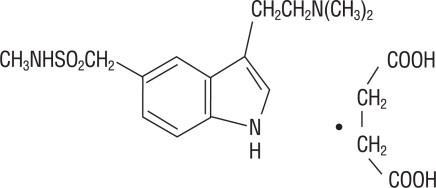
The empirical formula is C14H21N3O2SC4H6O4, representing a molecular weight of 413.5. Sumatriptan succinate is a white to off-white powder that is readily soluble in water and in saline.
ZEMBRACE SymTouch is a clear, colorless to pale yellow, sterile, nonpyrogenic solution for subcutaneous injection. Each 0.5 mL of ZEMBRACE SymTouch contains 4.2 mg of sumatriptan succinate equivalent to 3-mg of sumatriptan (base) and 4.15 mg of sodium chloride, USP in Water for Injection, USP.
The pH range of solution is approximately 4.2 to 5.3 and the osmolality of injection is approximately 291 mOsmol (275 to 315 mOsmol).
-
12 CLINICAL PHARMACOLOGY
12.1 Mechanism of Action
Sumatriptan binds with high affinity to human cloned 5-HT1B/1D receptors. Sumatriptan presumably exerts its therapeutic effects in the treatment of migraine headache through agonist effects at the 5-HT1B/1D receptors on intracranial blood vessels and sensory nerves of the trigeminal system, which result in cranial vessel constriction and inhibition of pro-inflammatory neuropeptide release.
12.2 Pharmacodynamics
Blood Pressure: Significant elevation in blood pressure, including hypertensive crisis, has been reported in patients with and without a history of hypertension [see Warnings and Precautions (5.8)].
Peripheral (Small) Arteries: In healthy volunteers (N = 18), a trial evaluating the effects of sumatriptan on peripheral (small vessel) arterial reactivity failed to detect a clinically significant increase in peripheral resistance.
Heart Rate: Transient increases in blood pressure observed in some subjects in clinical trials carried out during sumatriptan’s development as a treatment for migraine were not accompanied by any clinically significant changes in heart rate.
12.3 Pharmacokinetics
After a single 3-mg dose, ZEMBRACE SymTouch was bioequivalent to IMITREX subcutaneous injection.
Absorption and Bioavailability: The bioavailability of sumatriptan via subcutaneous site injection to 18 healthy male subjects was 97% ± 16% of that obtained following intravenous injection.
After a single 6-mg subcutaneous manual injection into the deltoid area of the arm in 18 healthy males (age: 24 ± 6 years, weight: 70 kg), the maximum serum concentration (Cmax) of sumatriptan was (mean ± standard deviation) 74 ± 15 ng/mL and the time to peak concentration (Tmax) was 12 minutes after injection (range: 5 to 20 minutes). In this trial, the same dose injected subcutaneously in the thigh gave a Cmax of 61 ± 15 ng/mL by manual injection versus 52 ±15 ng/mL by auto-injector techniques. The Tmax or amount absorbed was not significantly altered by either the site or technique of injection.
Distribution: Protein binding, determined by equilibrium dialysis over the concentration range of 10 to 1,000 ng/mL, is low, approximately 14% to 21%. The effect of sumatriptan on the protein binding of other drugs has not been evaluated.
Following a 6-mg subcutaneous injection into the deltoid area of the arm in 9 males (mean age: 33 years, mean weight: 77 kg) the volume of distribution central compartment of sumatriptan was 50 ± 8 liters and the distribution half-life was 15 ± 2 minutes.
Metabolism: In vitro studies with human microsomes suggest that sumatriptan is metabolized by MAO, predominantly the A isoenzyme. Most of a radiolabeled dose of sumatriptan excreted in the urine is the major metabolite indole acetic acid (IAA) or the IAA glucuronide, both of which are inactive.
Elimination: After a single 6-mg subcutaneous dose, 22% ± 4% was excreted in the urine as unchanged sumatriptan and 38% ± 7% as the IAA metabolite.
Following a 6-mg subcutaneous injection into the deltoid area of the arm, the systemic clearance of sumatriptan was 1,194 ± 149 mL/min and the terminal half-life was 115 ± 19 minutes.
Specific Populations:
Age: The pharmacokinetics of sumatriptan in the elderly (mean age: 72 years, 2 males and 4 females) and in subjects with migraine (mean age: 38 years, 25 males and 155 females) were similar to that in healthy male subjects (mean age: 30 years).
Patients with Hepatic Impairment: The effect of mild to moderate hepatic disease on the pharmacokinetics of subcutaneously administered sumatriptan has been evaluated. There were no significant differences in the pharmacokinetics of subcutaneously administered sumatriptan in moderately hepatically impaired subjects compared with healthy controls. The pharmacokinetics of subcutaneously administered sumatriptan in patients with severe hepatic impairment has not been studied. The use of ZEMBRACE SymTouch injection in this population is contraindicated [see Contraindications (4)].
Race: The systemic clearance and Cmax of subcutaneous sumatriptan were similar in black (n = 34) and Caucasian (n = 38) healthy male subjects.
Drug Interaction Studies:
Monoamine Oxidase-A Inhibitors: In a trial of 14 healthy females, pretreatment with an MAO-A inhibitor decreased the clearance of sumatriptan, resulting in a 2-fold increase in the area under the sumatriptan plasma concentration-time curve (AUC), corresponding to a 40% increase in elimination half-life.
-
13 NONCLINICAL TOXICOLOGY
13.1 Carcinogenesis, Mutagenesis, Impairment of Fertility
Carcinogenesis
In carcinogenicity studies in mouse and rat, sumatriptan was administered orally for 78 weeks and 104 weeks, respectively, at doses up to 160 mg/kg/day (the high dose in rat was reduced from 360 mg/kg/day during Week 21). The highest dose tested in mice and rats was approximately 130 and 260 times, respectively, the single MRHD of 6 mg administered subcutaneously on a mg/m2 basis. There was no evidence in either species of an increase in tumors related to sumatriptan administration.
Mutagenesis
Sumatriptan was negative in in vitro (bacterial reverse mutation [Ames], gene cell mutation in Chinese hamster V79/HGPRT, chromosomal aberration in human lymphocytes) and in vivo (rat micronucleus) assays.
Impairment of Fertility
When sumatriptan (0, 5, 50, or 500 mg/kg/day) was administered orally to male and female rats prior to and throughout the mating period, there was a treatment-related decrease in fertility secondary to a decrease in mating in animals treated with doses greater than 5 mg/kg/day. It is not clear whether this finding was due to an effect on males or females or both.
When sumatriptan was administered by subcutaneous injection to male and female rats prior to and throughout the mating period, there was no evidence of impaired fertility at doses up to 60 mg/kg/day.
13.2 Animal Toxicology and/or Pharmacology
Corneal Opacities: Dogs receiving oral sumatriptan developed corneal opacitiesand defects in the corneal epithelium. Corneal opacities were seen at the lowest dose tested, 2 mg/kg/day, and were present after 1 month of treatment. Defects in the corneal epithelium were noted in a 60-week study. Earlier examinations for these toxicities were not conducted and no-effect doses were not established; however, the relative plasma exposure at the lowest dose tested was approximately 3 times the human exposure after a 6-mg subcutaneous dose.
-
14 CLINICAL STUDIES
Clinical Studies with Sumatriptan Injection
In controlled clinical trials enrolling more than 1,000 patients during migraine attacks who were experiencing moderate or severe pain and 1 or more of the symptoms enumerated in Table 3, onset of relief began as early as 10 minutes following a 6-mg sumatriptan injection. Lower doses of sumatriptan injection may also prove effective, although the proportion of patients obtaining adequate relief was decreased and the latency to that relief is greater with lower doses.
In Study 1, 6 different doses of sumatriptan injection (n = 30 each group) were compared with placebo (n = 62), in a single-attack, parallel-group design, the dose response relationship was found to be as shown in Table 2.
Table 2: Proportion of Patients with Migraine Relief and Incidence of Adverse Reactions by Time and by Sumatriptan Dose in Study 1 a Relief is defined as the reduction of moderate or severe pain to no or mild pain after dosing without use of rescue medication Dose of Sumatriptan Injection Percent Subjects With Relief a Adverse Events Incidence (%) at 10 Minutes at 30 Minutes at 1 Hour at 2 Hours Placebo
1 mg
2mg
3 mg
4 mg
6 mg
8 mg5
10
7
17
13
10
2315
40
23
47
37
63
5724
43
57
57
50
73
8021
40
43
60
57
70
8355
63
63
77
80
83
93In 2 randomized, placebo-controlled clinical trials of sumatriptan injection 6 mg in 1,104 patients with moderate or severe migraine pain (Studies 2 and 3), the onset of relief was less than 10 minutes. Headache relief, as defined by a reduction in pain from severe or moderately severe to mild or no headache, was achieved in 70% of the patients within 1 hour of a single 6-mg subcutaneous dose of sumatriptan injection. Approximately 82% and 65% of patients treated with sumatriptan 6 mg had headache relief and were pain free within 2 hours, respectively.
Table 3 shows the 1- and 2-hour efficacy results for sumatriptan injection 6 mg in Studies 2 and 3.
Table 3: Proportion of Patients with Pain Relief and Relief of Migraine Symptoms After 1 and 2 Hours of Treatment in Studies 2 and 3 a P<0.05 versus placebo.
b A successful outcome in terms of clinical disability was defined prospectively as ability to work mildly impaired or ability to work and function normally.
c Includes patients that may have received an additional placebo injection 1 hour after the initial Injection.
d Includes patients that may have received an additional 6 mg of sumatriptan injection 1 hour after the initial injection.1-Hour Data Study 2 Study 3 Placebo
(n = 190)Sumatriptan
6 mg
(n = 384)Placebo
(n = 180)Sumatriptan
6 mg
(n = 350)Subjects with pain relief
(grade 0/1)18% 70%a 26% 70%a Subjects with no pain 5% 48%a 13% 49%a Subjects without nausea 48% 73%a 50% 73%a Subjects without photophobia 23% 56%a 25% 58%a Subjects with little or no clinical disabilityb 34% 76%a 34% 76%a 2-Hour Data Study 2 Study 3 Placeboc Sumatriptan
6 mgdPlaceboc Sumatriptan
6 mgdSubjects with pain relief (grade 0/1) 31% 81%a 39% 82%a Subjects with no pain 11% 63%a 19% 65%a Subjects without nausea 56% 82%a 63% 81%a Subjects without photophobia 31% 72%a 35% 71%a Subjects with little or no clinical disabilityb 42% 85%a 49% 84%a Sumatriptan injection also relieved photophobia, phonophobia (sound sensitivity), nausea, and vomiting associated with migraine attacks.
The efficacy of sumatriptan injections was unaffected by whether or not the migraine was associated with aura, duration of attack, gender or age of the subject, or concomitant use of common migraine prophylactic drugs (e.g., beta-blockers).
Clinical Study with ZEMBRACE SymTouch
In a double-blind, randomized, placebo-controlled clinical trial of ZEMBRACE SymTouch, 230 patients with migraine with or without aura received either ZEMBRACE SymTouch (N=111) or placebo (N=119) for a single migraine attack. The patients had a mean age of 41 years (range 18 to 65 years); approximately 76% were White and 85% were female.
The study excluded patients with medication overuse headache, treatment with onabotulinumtoxin A within 180 days, and patients with a history of cluster headache.
The primary efficacy endpoint was the proportion of patients who were pain-free (defined as a reduction from pre-dose moderate [Grade 2] or severe [Grade 3] pain to none [Grade 0]) 2 hours after the first dose. Of the ZEMBRACE SymTouch-treated patients, 46% were pain free at 2 hours after treatment compared to 27% of the placebo-treated patients.
-
16 HOW SUPPLIED/STORAGE AND HANDLING
16.1 How Supplied
- ZEMBRACE SymTouch 3 mg/0.5 mL Injection contains sumatriptan as the succinate salt and is supplied as a clear, colorless to pale yellow, sterile, nonpyrogenic solution in a prefilled, ready-to-use, single dose, disposable auto-injector unit (NDC # 67857-809-37).
- Each carton contains 4 units (NDC # 67857-809-38) and a Patient Information and Instructions for Use leaflet.
-
17 PATIENT COUNSELING INFORMATION
Advise the patient to read the FDA-approved patient labeling (Patient Information and Instructions for Use).
Risk of Myocardial Ischemia and/or infarction, Prinzmetal's Angina, Other Vasospasm-Related Events, Arrhythmias, and Cerebrovascular Events
Inform patients that ZEMBRACE SymTouch injection may cause serious cardiovascular side effects such as myocardial infarction or stroke. Although serious cardiovascular events can occur without warning symptoms, patients should be alert for the signs and symptoms of chest pain, shortness of breath, irregular heartbeat, significant rise in blood pressure, weakness, and slurring of speech and should ask for medical advice when observing any indicative sign or symptoms are observed. Apprise patiens of the importance of this follow-up [see Warnings and Precautions (5.1, 5.2, 5.4, 5.5, 5.8)].
Hypersensitivity Reactions
Inform patients that anaphylactic reactions have occurred in patients receiving sumatriptan injection. Such reactions can be life threatening or fatal. In general, anaphylactic reactions to drugs are more likely to occur in individuals with a history of sensitivity to multiple allergens [see Contraindications (4) and Warnings and Precautions (5.9)].
Concomitant Use with Other Triptans or Ergot Medications
Inform patients that use of ZEMBRACE SymTouch injection within 24 hours of another triptan or an ergot-type medication (including dihydroergotamine or methylsergide) is contraindicated [see Contraindications (4), Drug Interactions (7.1, 7.3)].
Serotonin Syndrome
Caution patients about the risk of serotonin syndrome with the use of ZEMBRACE SymTouch injection or other triptans, particularly during combined use with SSRIs, SNRIs, TCAs, and MAO inhibitors [see Warnings and Precautions (5.7), Drug Interactions (7.4)].
Medication Overuse Headache
Inform patients that use of acute migraine drugs for 10 or more days per month may lead to an exacerbation of headache and encourage patients to record headache frequency and drug use (e.g., by keeping a headache diary) [see Warnings and Precautions (5.6)].
Pregnancy
Advise patients to notify their healthcare provider if they become pregnant during treatment or plan to become pregant [see Use in Specific Population (8.1)].
Lactation
Advise patients to notify their healthcare provider if they are breastfeeding or plan to breastfeed [see Use in Specific Populations (8.2)].
Ability to Perform Complex Tasks
Treatment with ZEMBRACE SymTouch injection may cause somnolence and dizziness; instruct patients to evaluate their ability to perform complex tasks during migraine attacks and after administration of ZEMBRACE SymTouch injection.
How to Use ZEMBRACE SymTouch
Provide patients instruction on the proper use of ZEMBRACE SymTouch injection if they are able to self-administer ZEMBRACE SymTouch injection in medically unsupervised conditions.
Inform patients that the needle in the ZEMBRACE SymTouch penetrates approximately ¼ of an inch (6 mm). Inform patients that the injection is intended to be given subcutaneously and intramuscular or intravascular delivery should be avoided. Instruct patients to use injection sites with an adequate skin and subcutaneous thickness to accommodate the length of the needle.
ZEMBRACE and SymTouch are registered trademarks of Dr. Reddy’s Laboratories Limited
Manufactured for: Dr. Reddy’s Laboratories Limited
by Ajinomoto Althea Inc., San Diego, CA 92121Distributed by: Promius Pharma, LLC, Princeton, NJ 08540
-
PATIENT PACKAGE INSERT
Patient Information
ZEMBRACE SymTouch (Zem-brace Sim-Touch)
(sumatriptan succinate)
InjectionWhat is the most important information I should know about ZEMBRACE SymTouch?
ZEMBRACE SymTouch can cause serious side effects, including:
Heart attack and other heart problems. Heart problems may lead to death.
Stop taking ZEMBRACE SymTouch and get emergency medical help right away if you have any of the following symptoms of a heart attack:- discomfort in the center of your chest that lasts for more than a few minutes, or that goes away and comes back
- severe tightness, pain, pressure, or heaviness in your chest, throat, neck, or jaw
- pain or discomfort in your arms, back, neck, jaw, or stomach
- shortness of breath with or without chest discomfort
- breaking out in a cold sweat
- nausea or vomiting
- feeling lightheaded
ZEMBRACE SymTouch is not for people with risk factors for heart disease unless a heart exam is done and shows no problem. You have a higher risk for heart disease if you:
- have high blood pressure
- have high cholesterol levels
- smoke
- are overweight
- have diabetes
- have a family history of heart disease
What is ZEMBRACE SymTouch?
ZEMBRACE SymTouch is a prescription medicine used to treat acute migraine headaches with or without aura in adults who have been diagnosed with migraine.
ZEMBRACE SymTouch is not used to treat other types of headaches such as hemiplegic (that make you unable to move on one side of your body) or basilar (rare form of migraine with aura) migraines.
ZEMBRACE SymTouch is not used to prevent or decrease the number of migraine you have. It is not known if ZEMBRACE SymTouch is safe and effective in children under 18 years of age.
Who should not take ZEMBRACE SymTouch?
Do not take ZEMBRACE SymTouch if you have:
- heart problems or a history of heart problems
- narrowing of blood vessels to your legs, arms, stomach, or kidney (peripheral vascular disease)
- uncontrolled high blood pressure
- hemiplegic migraines or basilar migraines. If you are not sure if you have these types of migraines, ask your healthcare provider.
- had a stroke, transient ischemic attacks (TIAs), or problems with your blood circulation
- severe liver problems
- an allergy to sumatriptan or any of the ingredients in ZEMBRACE SymTouch. See the end of this leaflet for a complete list of ingredients in ZEMBRACE SymTouch.
- taken any of the following medicines in the last 24 hours:
- almotriptan
- eletriptan
- frovatriptan
- naratriptan
- rizatriptan
- ergotamines
- dihydroergotamine
Ask your healthcare provider if you are not sure if your medicine is listed above.
What should I tell my healthcare provider before taking ZEMBRACE SymTouch?
Before taking ZEMBRACE SymTouch, tell your healthcare provider about all of your medical conditions, including if you:
- have high blood pressure
- have high cholesterol
- have diabetes
- smoke
- are overweight
- have heart problems or family history of heart problems or stroke
- have kidney problems
- have liver problems
- have had epilepsy or seizures
- are not using effective birth control
- are pregnant or plan to become pregnant. It is not known if ZEMBRACE SymTouch can harm your unborn baby.
- are breastfeeding or plan to breastfeed. ZEMBRACE SymTouch passes into your breast milk. It is not known if this can harm your baby. Talk with your healthcare provider about the best way to feed your baby if you take ZEMBRACE SymTouch.
Tell your healthcare provider about all the medicines you take, including prescription and over-the-counter medicines, vitamins, and herbal supplements.
Using ZEMBRACE SymTouch with certain other medicines can affect each other, causing serious side effects.
Especially tell your healthcare provider if you take anti-depressant medicines called:
- selective serotonin reuptake inhibitors (SSRIs)
- serotonin norepinephrine reuptake inhibitors (SNRIs)
- tricyclic antidepressants (TCAs)
- monoamine oxidase inhibitors (MAOIs)
Ask your healthcare provider or pharmacist for a list of these medicines if you are not sure.
Know the medicines you take. Keep a list of them to show your healthcare provider or pharmacist when you get a new medicine.
How should I take ZEMBRACE SymTouch?
- Certain people should take their first dose of ZEMBRACE SymTouch in their healthcare provider’s office or in another medical setting. Ask your healthcare provider if you should take your first dose in a medical setting.
- Use ZEMBRACE SymTouch exactly as your healthcare provider tells you to use it.
- Your healthcare provider may change your dose. Do not change your dose without first talking with your healthcare provider.
- For adults, the usual dose is a single injection given just below the skin.
- You should give an injection as soon as the symptoms of your headache start, but it may be given at any time during a migraine headache attack.
- If you did not get any relief after the first injection, do not give a second injection without first talking with your healthcare provider.
- You may use a second dose of ZEMBRACE SymTouch after the first dose of ZEMBRACE SymTouch OR after one dose of another sumatriptan medication separated by at least 1 hour, but not sooner, if your headache comes back or you only get some relief after your first injection.
- Do not take more than a total of 12 mg of ZEMBRACE SymTouch in a 24-hour period. Talk to your doctor about how many ZEMBRACE SymTouch you can take in a 24 hour period if you take another form of sumatriptan medication in between ZEMBRACE SymTouch.
- If you use too much ZEMBRACE SymTouch, call your healthcare provider or go to the nearest hospital emergency room right away.
- You should write down when you have headaches and when you take ZEMBRACE SymTouch so you can talk with your healthcare provider about how ZEMBRACE SymTouch is working for you.
What should I avoid while taking ZEMBRACE SymTouch?
ZEMBRACE SymTouch can cause dizziness, weakness, or drowsiness. If you have these symptoms, do not drive a car, use machinery, or do anything where you need to be alert.
What are the possible side effects of ZEMBRACE SymTouch?
See “What is the most important information I should know about Zembrace SymTouch?” ZEMBRACE SymTouch may cause serious side effects, including:
- changes in color or sensation in your fingers and toes (Raynaud’s syndrome)
-
stomach and intestinal problems (gastrointestinal and colonic ischemic events). Symptoms of gastrointestinal and colonic ischemic events include:
- sudden or severe stomach pain
- stomach pain after meals
- weight loss
- nausea or vomiting
- constipation or diarrhea
- bloody diarrhea
- fever
-
problems with blood circulation to your legs and feet (peripheral vascular ischemia).
Symptoms of peripheral vascular ischemia include:- cramping and pain in your legs or hips
- feeling of heaviness or tightness in your leg muscles
- burning or aching pain in your feet or toes while resting
- numbness, tingling, or weakness in your legs
- cold feeling or color changes in 1 or both legs or feet
- hives (itchy bumps); swelling of your tongue, mouth, or throat.
- medication overuse headaches. Some people who use too many ZEMBRACE SymTouch injections may have worse headaches (medication overuse headache). If your headaches get worse, your healthcare provider may decide to stop your treatment with ZEMBRACE SymTouch.
-
serotonin syndrome. Serotonin syndrome is a rare but serious problem that can happen in people using ZEMBRACE SymTouch, especially if ZEMBRACE SymTouch is used with anti-depressant medicines called SSRIs or SNRIs.
Call your healthcare provider right away if you have any of the following symptoms of serotonin syndrome:
- mental changes such as seeing things that are not there (hallucinations), agitation, or coma
- fast heartbeat
- changes in blood pressure
- high body temperature
- tight muscles
- trouble walking
-
seizures. Seizures have happened in people taking ZEMBRACE SymTouch who have never had seizures before. Talk with your healthcare provider about your chance of having seizures while you take ZEMBRACE SymTouch.
The most common side effects of ZEMBRACE SymTouch include:
- pain or redness at your injection site
- tingling or numbness in your fingers or toes
- dizziness
- warm, hot, burning feeling to your face (flushing)
- discomfort or stiffness in your neck
- feeling weak, drowsy, or tired
Tell your healthcare provider if you have any side effect that bothers you or that does not go away.
These are not all the possible side effects of ZEMBRACE SymTouch. Call your doctor for medical advice about side effects. You may report side effects to FDA at 1- 800-FDA-1088.
How should I store ZEMBRACE SymTouch?
- Store between 68° and 77°F (20° and 25°C)
- Store your medicine away from light.
- Keep your medicine in the packaging or carrying case provided with it.
Keep ZEMBRACE SymTouch and all medicines out of the reach of children.
General information about the safe and effective use of ZEMBRACE SymTouch.
Medicines are sometimes prescribed for purposes other than those listed in Patient Information leaflets. Do not use ZEMBRACE SymTouch for a condition for which it was not prescribed. Do not give ZEMBRACE SymTouch to other people, even if they have the same symptoms you have. It may harm them.
This Patient Information leaflet summarizes the most important information about ZEMBRACE SymTouch. If you would like more information, talk with your healthcare provider. You can ask your healthcare provider or pharmacist for information about ZEMBRACE SymTouch that is written for healthcare professionals.
For more information, go to www.drreddys.com or call 1-888-966-8766.
What are the ingredients in ZEMBRACE SymTouch Injection?
Active ingredient: sumatriptan succinate
Inactive ingredients: sodium chloride, water for injection
ZEMBRACE and SymTouch are registered trademarks of Dr. Reddy’s Laboratories Limited
Manufactured for: Dr. Reddy’s Laboratories Limited; by Ajinomoto Althea, Inc., San Diego, CA 92121
Distributed by: Promius Pharma, LLC., Princeton, NJ 08540
This Patient Information has been approved by the U.S. Food and Drug Administration. Revised: Jun 2019
-
INSTRUCTIONS FOR USE
Instructions for Use
ZEMBRACE™ SymTouch™ (Zem-brace Sim-Touch)
(sumatriptan succinate)
Injection
Read this Instructions for Use before you start to use the ZEMBRACE™ SymTouch™. There may be new information. This information does not take the place of talking with your healthcare provider about your medical condition or treatment. You and your healthcare provider should talk about ZEMBRACE SymTouch when you start taking it and at regular checkups.
The ZEMBRACE SymTouch Autoinjector is a single-use, pre-filled injection device with the exact dose you need.
The device should be used only 1 time and then discarded.
 Important Precautions
Important Precautions
Keep out of reach of children.
Do not use after the expiration date has passed.
Do not store or expose to high temperatures.
Do not freeze.
Do not remove the Red Cap until you are ready to inject.
Do not use if dropped after removing the Red Cap.
Do not put or press thumb, fingers or hand over the Yellow Needle Guard.
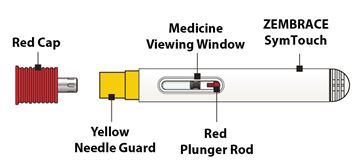
Step 1 – Inspect Autoinjector and Gather Supplies
1A- Remove Autoinjector from the carton.
1B – Check the Expiration Date on the Autoinjector
Do not use if the expiration date has passed.

1C – Inspect the medicine through the Medicine Viewing Window
Inspect the appearance of ZEMBRACE SymTouch Autoinjector medicine through the medicine window. It must be a clear, colorless to pale yellow solution.
Do not inject the medicine if the solution looks discolored or cloudy or contains lumps, flakes, or particles.
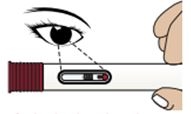
1D – Gather the following supplies
- Autoinjector
- Alcohol Swab
- Sterile Cotton Ball or Gauze
- Puncture-Resistant Sharps Container
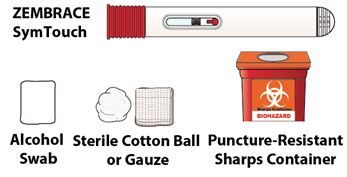
Step 2 – Choose and Prepare Your Injection Site
2A - Choose your injection site
The recommended injection sites are the sides of the thighs and the arms.
Caution: Do not inject where your skin is scarred, bruised, tender, red or near any open wound.
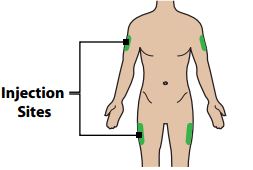
2B – Clean the injection site with an alcohol swab
Do not touch injection site area after cleaning.
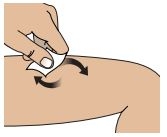
2C - Remove the Red Cap
Hold the body of the Autoinjector in one hand and pull the Red Cap straight off.
Warning: Do not put or press thumb, fingers or hand over the Yellow Needle Guard, doing so may result in a needle stick injury.
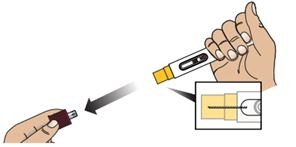
Step 3 – Inject the Medicine
3A – Place Autoinjector straight on your injection site
Place the Autoinjector straight on your injection site (90 degrees) with the Yellow Needle Guard end gently pressed against your skin.
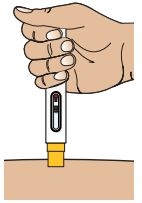
3B - Perform Injection
Press and hold the Autoinjector down against your skin. You will hear the first “Click 1” as the injection starts. Continue to hold the device down until you hear the second “Click 2.”
Wait 5 seconds before you remove the Autoinjector!
After “Click 2,” continue to hold down and slowly count to 5 to make sure you receive your full dose.

Important: To receive your full dose, always hold the Autoinjector down on your injection site for additional time after you hear the second click. This allows all of the medicine to be delivered.
3C - Remove Autoinjector from skin
Remove the Autoinjector by lifting it straight away from your skin. The Yellow Needle Guard will drop down and lock over the needle.
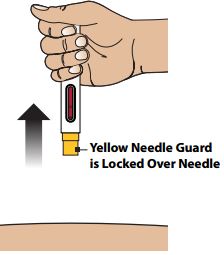
Step 4 – Confirm Injection and Dispose the Autoinjector
4A - Confirm Red Color in Medicine Viewing Window
Look to confirm that the Red Plunger Rod has filled the Medicine Viewing Window. This means you received the full dose.
Caution: Call your healthcare provider if the Red Plunger Rod has not filled the Medicine Viewing Window. This may mean that only a partial dose was delivered.
Do not try to reuse the Autoinjector.
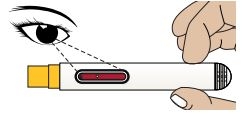
4B Disposal of the Autoinjector
Put your used Autoinjector, caps, needles, and sharps in an FDA-cleared sharps disposal container right away after use. Do not throw away (dispose of) loose needles and syringes in your household trash. Do not recycle your used sharps disposal container.
If you do not have a FDA-cleared sharps disposal container, you may use a household container that is: made of a heavy-duty plastic; can be closed with a tight-fitting, puncture-resistant lid, without sharps being able to come out; upright and stable during use; leak-resistant; and properly labeled to warn of hazardous waste inside the container.
When your sharps disposal container is almost full, you will need to follow your community guidelines for the right way to dispose of your sharps disposal container. There may be state or local laws about how you should throw away used needles and syringes. For more information about safe sharps disposal, and for specific information about sharps disposal in the state that you live in, go to the FDA’s website at: http://www.fda.gov/safesharpsdisposal.
Do not dispose of your used sharps disposal container in your household trash unless your community guidelines permit this. Do not recycle your used sharps disposal container.
If needed, make sure you get a refill of your Autoinjector.
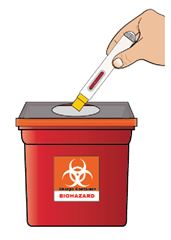
4C - Treat Injection Site
Treat the injection site with a cotton ball, gauze pad or bandage, as needed.
Do not rub the injection site.
ZEMBRACE SymTouch are registered trademarks of Dr. Reddy’s Laboratories, Ltd.

This Instructions for Use has been approved by the U.S. Food and Drug Administration. Mar 2017
- PRINCIPAL DISPLAY PANEL - NDC: 67857-809-37 - Autoinjector Label
- PRINCIPAL DISPLAY PANEL - NDC: 67857-809-38 - 4-count Carton Label (Partition)
- PRINCIPAL DISPLAY PANEL - NDC: 67857-809-38 - 4-count Carton Label (Interior)
- PRINCIPAL DISPLAY PANEL - NDC: 67857-809-38 - 4-ct Carton Label (Exterior)
-
INGREDIENTS AND APPEARANCE
ZEMBRACE SYMTOUCH
sumatriptan injection, solutionProduct Information Product Type HUMAN PRESCRIPTION DRUG Item Code (Source) NDC: 67857-809 Route of Administration SUBCUTANEOUS Active Ingredient/Active Moiety Ingredient Name Basis of Strength Strength SUMATRIPTAN SUCCINATE (UNII: J8BDZ68989) (SUMATRIPTAN - UNII:8R78F6L9VO) SUMATRIPTAN 3 mg Packaging # Item Code Package Description Marketing Start Date Marketing End Date 1 NDC: 67857-809-38 4 in 1 CARTON 02/22/2016 1 NDC: 67857-809-37 1 in 1 SYRINGE; Type 9: Other Type of Part 3 Combination Product (e.g., Drug/Device/Biological Product) Marketing Information Marketing Category Application Number or Monograph Citation Marketing Start Date Marketing End Date NDA NDA208223 02/22/2016 Labeler - Promius Pharma, LLC (020408265)
Trademark Results [ZEMBRACE SymTouch]
Mark Image Registration | Serial | Company Trademark Application Date |
|---|---|
 ZEMBRACE SYMTOUCH 87150791 5478282 Live/Registered |
UPSHER-SMITH LABORATORIES, LLC 2016-08-25 |
© 2025 FDA.report
This site is not affiliated with or endorsed by the FDA.
